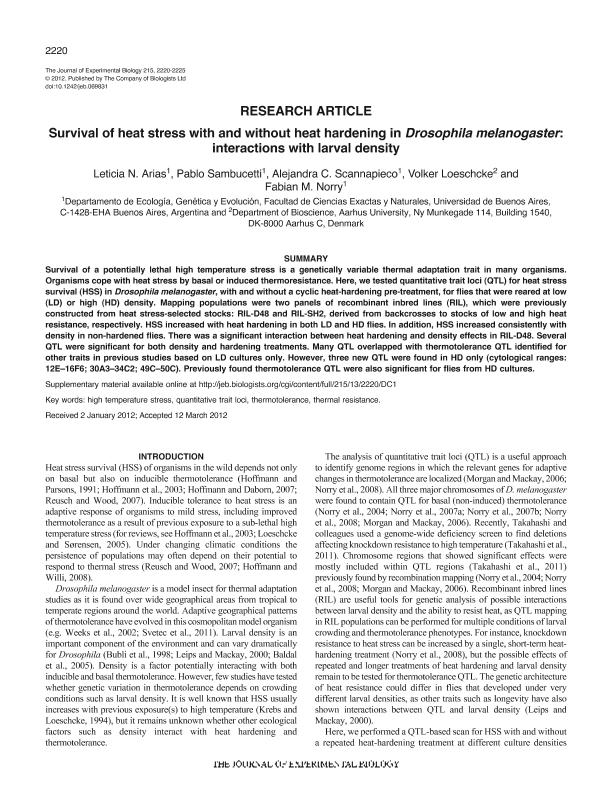Artículo
Survival of heat stress with and without heat hardening in Drosophila melanogaster: interactions with larval density
Arias, Leticia Noemi ; Sambucetti, Pablo Daniel
; Sambucetti, Pablo Daniel ; Scannapieco, Alejandra Carla
; Scannapieco, Alejandra Carla ; Loeschcke, Volker; Norry, Fabian Marcelo
; Loeschcke, Volker; Norry, Fabian Marcelo
 ; Sambucetti, Pablo Daniel
; Sambucetti, Pablo Daniel ; Scannapieco, Alejandra Carla
; Scannapieco, Alejandra Carla ; Loeschcke, Volker; Norry, Fabian Marcelo
; Loeschcke, Volker; Norry, Fabian Marcelo
Fecha de publicación:
03/2012
Editorial:
Company of Biologists
Revista:
Journal of Experimental Biology
ISSN:
0022-0949
Idioma:
Inglés
Tipo de recurso:
Artículo publicado
Clasificación temática:
Resumen
Survival of a potentially lethal high temperature stress is a genetically variable thermal adaptation trait in many organisms. Organisms cope with heat stress by basal or induced thermoresistance. Here, we tested quantitative trait loci (QTL) for heat stress survival (HSS) in Drosophila melanogaster, with and without a cyclic heat-hardening pre-treatment, for flies that were reared at low (LD) or high (HD) density. Mapping populations were two panels of recombinant inbred lines (RIL), which were previously constructed from heat stress-selected stocks: RIL-D48 and RIL-SH2, derived from backcrosses to stocks of low and high heat resistance, respectively. HSS increased with heat hardening in both LD and HD flies. In addition, HSS increased consistently with density in non-hardened flies. There was a significant interaction between heat hardening and density effects in RIL-D48. Several QTL were significant for both density and hardening treatments. Many QTL overlapped with thermotolerance QTL identified for other traits in previous studies based on LD cultures only. However, three new QTL were found in HD only (cytological ranges: 12E–16F6; 30A3–34C2; 49C–50C). Previously found thermotolerance QTL were also significant for flies from HD cultures.
Archivos asociados
Licencia
Identificadores
Colecciones
Articulos(SEDE CENTRAL)
Articulos de SEDE CENTRAL
Articulos de SEDE CENTRAL
Citación
Arias, Leticia Noemi; Sambucetti, Pablo Daniel; Scannapieco, Alejandra Carla; Loeschcke, Volker; Norry, Fabian Marcelo; Survival of heat stress with and without heat hardening in Drosophila melanogaster: interactions with larval density; Company of Biologists; Journal of Experimental Biology; 215; 13; 3-2012; 2220-2225
Compartir
Altmétricas



